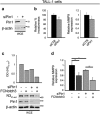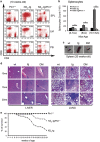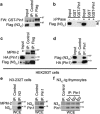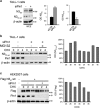Prolyl-isomerase Pin1 controls Notch3 protein expression and regulates T-ALL progression
- PMID: 26876201
- PMCID: PMC5024153
- DOI: 10.1038/onc.2016.5
Prolyl-isomerase Pin1 controls Notch3 protein expression and regulates T-ALL progression
Abstract
Deregulated Notch signaling is associated with T-cell Acute Lymphoblastic Leukemia (T-ALL) development and progression. Increasing evidence reveals that Notch pathway has an important role in the invasion ability of tumor cells, including leukemia, although the underlying molecular mechanisms remain mostly unclear. Here, we show that Notch3 is a novel target protein of the prolyl-isomerase Pin1, which is able to regulate Notch3 protein processing and to stabilize the cleaved product, leading to the increased expression of the intracellular domain (N3IC), finally enhancing Notch3-dependent invasiveness properties. We demonstrate that the combined inhibition of Notch3 and Pin1 in the Notch3-overexpressing human leukemic TALL-1 cells reduces their high invasive potential, by decreasing the expression of the matrix metalloprotease MMP9. Consistently, Pin1 depletion in a mouse model of Notch3-induced T-ALL, by reducing N3IC expression and signaling, impairs the expansion/invasiveness of CD4(+)CD8(+) DP cells in peripheral lymphoid and non-lymphoid organs. Notably, in in silico gene expression analysis of human T-ALL samples we observed a significant correlation between Pin1 and Notch3 expression levels, which may further suggest a key role of the newly identified Notch3-Pin1 axis in T-ALL aggressiveness and progression. Thus, combined suppression of Pin1 and Notch3 proteins may be exploited as an additional target therapy for T-ALL.
Figures







Similar articles
-
Notch3/Jagged1 circuitry reinforces notch signaling and sustains T-ALL.Neoplasia. 2014 Dec;16(12):1007-17. doi: 10.1016/j.neo.2014.10.004. Neoplasia. 2014. PMID: 25499214 Free PMC article.
-
Intrathymic Notch3 and CXCR4 combinatorial interplay facilitates T-cell leukemia propagation.Oncogene. 2018 Dec;37(49):6285-6298. doi: 10.1038/s41388-018-0401-2. Epub 2018 Jul 23. Oncogene. 2018. PMID: 30038265 Free PMC article.
-
Characterization of activating mutations of NOTCH3 in T-cell acute lymphoblastic leukemia and anti-leukemic activity of NOTCH3 inhibitory antibodies.Oncogene. 2016 Nov 24;35(47):6077-6086. doi: 10.1038/onc.2016.133. Epub 2016 May 9. Oncogene. 2016. PMID: 27157619 Free PMC article.
-
Notch/CXCR4 Partnership in Acute Lymphoblastic Leukemia Progression.J Immunol Res. 2019 Jun 27;2019:5601396. doi: 10.1155/2019/5601396. eCollection 2019. J Immunol Res. 2019. PMID: 31346528 Free PMC article. Review.
-
The Notch3 Receptor and Its Intracellular Signaling-Dependent Oncogenic Mechanisms.Adv Exp Med Biol. 2018;1066:205-222. doi: 10.1007/978-3-319-89512-3_10. Adv Exp Med Biol. 2018. PMID: 30030828 Review.
Cited by
-
Targeting Notch to Maximize Chemotherapeutic Benefits: Rationale, Advanced Strategies, and Future Perspectives.Cancers (Basel). 2021 Oct 12;13(20):5106. doi: 10.3390/cancers13205106. Cancers (Basel). 2021. PMID: 34680255 Free PMC article. Review.
-
Pin1 inhibition exerts potent activity against acute myeloid leukemia through blocking multiple cancer-driving pathways.J Hematol Oncol. 2018 May 30;11(1):73. doi: 10.1186/s13045-018-0611-7. J Hematol Oncol. 2018. PMID: 29848341 Free PMC article.
-
Nanocarrier of Pin1 inhibitor based on supercritical fluid technology inhibits cancer metastasis by blocking multiple signaling pathways.Regen Biomater. 2023 Feb 27;10:rbad014. doi: 10.1093/rb/rbad014. eCollection 2023. Regen Biomater. 2023. PMID: 36915713 Free PMC article.
-
Notch Signaling Activation as a Hallmark for Triple-Negative Breast Cancer Subtype.J Oncol. 2019 Jul 11;2019:8707053. doi: 10.1155/2019/8707053. eCollection 2019. J Oncol. 2019. PMID: 31379945 Free PMC article. Review.
-
The role of aurora A and polo-like kinases in high-risk lymphomas.Blood Adv. 2019 Jun 11;3(11):1778-1787. doi: 10.1182/bloodadvances.2019000232. Blood Adv. 2019. PMID: 31186254 Free PMC article. Review.
References
-
- Artavanis-Tsakonas S, Rand MD, Lake RJ. Notch signaling: cell fate control and signal integration in development. Science 1999; 284: 770–776. - PubMed
-
- Screpanti I, Bellavia D, Campese AF, Frati L, Gulino A. Notch a unifying target in T-cell acute lymphoblastic leukemia? Trends Mol Med 2003; 9: 30–35. - PubMed
-
- Grabher C, von Boehmer H, Look AT. Notch 1 activation in the molecular pathogenesis of T-cell acute lymphoblastic leukaemia. Nat Rev Cancer 2006; 6: 347–359. - PubMed
Publication types
MeSH terms
Substances
LinkOut - more resources
Full Text Sources
Other Literature Sources
Molecular Biology Databases
Research Materials
Miscellaneous

